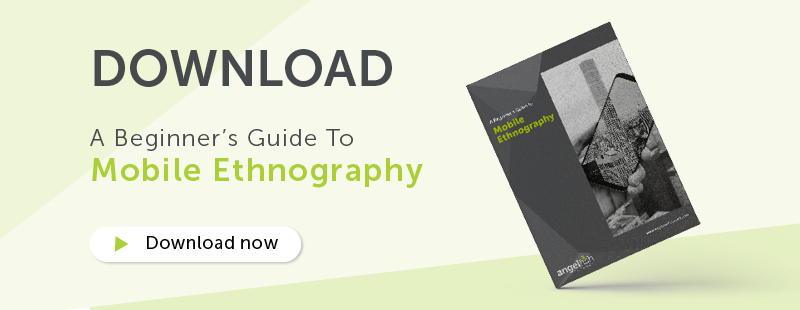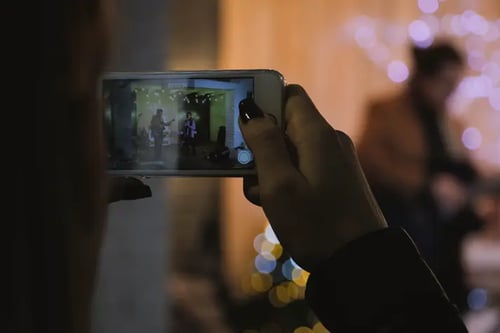
5 Ways Mobile Ethnography Can Help Research Consumer Behaviour
Ethnography is a type of research that allows researchers to observe respondents in their natural environment. Initially used in anthropological studies to learn more about cultures and societies, it essentially turns research inside out. Instead of bringing respondents to the researcher, ethnography involves researchers embedding themselves in their participants’ environment so they can observe their experiences as and when they happen, resulting in deeper insights.
Mobile ethnography is the next step in this methodology. By using smartphones, participants can capture real-time moments through video diaries, in-the-moment photos, and short reflections. It’s discreet, fast, flexible, and allows researchers to gain deep insights into customer behaviour without disrupting everyday life.
As of early 2025, 91% of the global population owns a mobile phone, and average daily screen time has reached 4.9 hours. With 97% of U.S. adults owning a mobile phone, mobile ethnography is more accessible and natural than ever, making it a powerful tool for qualitative market research.
Below are five key ways mobile ethnography can strengthen your next qualitative market research project.
1. Mobile has already been adopted by consumers
The technological advances of the last few decades have made it easier than ever for ethnography to slot into our daily lives. Today’s smartphones are basically mini-computers that are always connected and equipped with a camera - and because participants are used to using mobiles in their daily lives, it’s a really natural way for them to get involved with market research. Not only does this pre-existing comfort make people more willing to take part in ethnographic research, but because they use mobiles every day, you also don’t have to teach your potential respondents what to do - making it the perfect tool to effortlessly capture natural consumer behaviour.
2. Consumers find mobile unobtrusive
People act differently when a researcher is in the room with them - and the same is true when they have to look down the lens of a camera or speak into a microphone. It’s human nature to be aware of when we are being observed, but if consumers can record themselves with their own phones, it’s different. People today are used to snapping photos or uploading short videos using their mobiles, which means that because mobile ethnography doesn’t disturb their normal routine, they will be less inclined to modify their behaviour. Not only that but because mobile ethnography is also discreet, it means participants can take part in research whilst going about their everyday lives - and no one else around them needs to be aware of it.
3. Organic feedback is available in real-time
Mobile ethnography makes it easier to gather organic customer insights as and when they interact with products, as opposed to a distorted recollection a few hours later where details can easily be forgotten. This instant approach is a fantastic way for researchers to unlock additional insights into customer behaviour and experience, such as the level of customer service in a shop or how easy the layout is to navigate. It also allows for other emotional responses to seep through, as well as contextual insights about the location and background. For example, your participants might really rate the level of service in a store but find the music too loud - and this sort of unfiltered feedback can really add value to your market research project.
4. It’s autonomous and flexible
More traditional market research methodologies often require a fair amount of preparation and supervision. However, online methods such as mobile ethnography remove the need for a third-party adviser, which not only helps to deliver more true responses and reactions but also gives researchers time to analyse the data more accurately and gain better consumer insights. Additionally, it adds a lot of flexibility to your research too, because the course of a project can be corrected if something isn’t quite working and the data coming through doesn’t yield the results you were hoping for. Finally, because respondents can manage their own time, they also tend to be more engaged. And let’s face it - more engaged respondents mean deeper insights into their behaviour.
5. It increases the scope of your research
Because of the reduced logistical and financial burden of mobile ethnographic research, you can also greatly expand the scope of your research too.
Thanks to widespread mobile access and the rise of 5G technology (used by 58% of global mobile users), mobile ethnography enables researchers to reach participants across diverse geographic locations without logistical constraints.
With over 7.8 billion mobile subscriptions globally, researchers can tap into a vast pool of respondents, making it easier to meet strict criteria and expand the scope of qualitative research projects.
This can be especially useful if you’re working with strict criteria! And since you don’t need moderators, equipment or even a room, you aren’t restricted by the burden of traditional methodologies, which means you’ll most likely enjoy higher response rates as well.

Case Study Spotlight
Curious how mobile ethnography works in practice? Check out our case study, where we used mobile ethnography to uncover how female gamers experience inclusivity in digital spaces. The real-time feedback provided rich emotional and contextual insights that traditional methods might have missed.
Things to Consider
There are of course still some things to think about to make sure your mobile ethnography goes off without a hitch. For starters, you will have to plan your project extensively and fine tune your respondent screening process to ensure the more relaxed approach won’t be taken advantage of. In addition, you’ll also need to carefully consider issues surrounded privacy, security and reliability as well, and make sure you choose the right software to ensure everything runs smoothly.
Ready to Get Started?
At the end of the day, the more valuable feedback you receive from a greater group of engaged respondents, the better you’ll understand consumer behaviour. From video diaries to in-the-moment photos, mobile ethnography gives researchers the chance to peak into participants’ lives more clearly than ever before. It is a fantastic way to get to grips with what people are truly thinking and observe how they really act - and because it fits in around people's busy lives, it’s a win-win for everyone!
Are you interested in using mobile ethnography as part of your next qualitative market research project? Get your free guide to launching a successful mobile ethnography project, which includes a includes a quick-fire checklist.
Further Reading on Mobile Ethnography
Interested in learning more about digital and mobile ethnography? Explore these related blogs:














